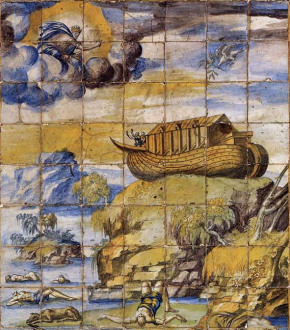
.............................................................................................................................................................
Was there no rain before the flood?
BibleStudy.org
The scripture that mentions no rain before the great flood is found in
Genesis 2.
It states, "When the Lord God made the universe, there
were no plants on the earth and no seeds had sprouted, because he had not sent
any rain . . . but water would come up from beneath the surface and water the
ground" (Genesis 2:5-6).
According to some, this condition of no rain only lasted until shortly
after the creation events mentioned in Genesis 1.
If this is true, then this fog and mist began the hydrologic cycle,
which eventually led to water falling from the sky.
On the other hand, there are other factors to consider that lead one
to believe there were no showers before Noah's flood.
The timing of the formation of rainbows offers evidence that it did
not rain on the earth until after the deluge.
If there was no rain until after the deluge then rainbows "in
the cloud" would be a new phenomenon.
They would not have existed before the flood since they are created by
the refraction of light passing through suspended water
(water drops).
It seems likely that God used the new phenomenon known as rainbows as
a 'reminder' to both him and man of the promise he made to not
bring another flood upon the earth (Genesis
9:11-16).
Compared to today, the earth before the deluge was
a much different place to live.
For example, evidence points to the fact that, before the deluge, the
earth had a year consisting of 360 days as opposed to today's year which
consists of a fraction more than 365 days.
A comparison of several verses in Genesis (Genesis 7:24, 7:11, and 8:4) shows
that five months consisted of 150 days.
This would mean that the days before the flood were slightly longer
than the present 24-hour days.
The earth before the flood, even without regular rain, was a lush
tropical forest with large amounts of vegetation.
Since the days were longer the temperature was warmer. After the
waters receded the ice ages began and the earth's ecosystem changed.
Before God brought the waters and then allowed rain to fall, there
would have been less wind and atmospheric turbulence.
Winds are caused by temperature differences cause by the tilt of the
earth's axis, mountain systems and ice caps. All of these cause unequal
regions of hot and cold on the globe.
The pre-flood earth was warmer, had more vegetation, and
smaller oceans than today.
The atmosphere of the earth, before the flood, had less particles for
rain to condense around than what we find today. Particles called condensation
nuclei are absolutely essential to the formation of water droplets.
"Some atmospheric particles . . . formed by the evaporation of
water from droplets of sea spray, are natural and even beneficial atmospheric
constituents. Very small particles called condensation nuclei serve as bodies
for atmospheric water vapor to condense upon . . . " (Manahan, Stanley E., Environmental Chemistry
7th edition).
If the earth before the flood had smaller oceans, and no rain, then
the production of particles for water drops to condense around would be very
small if not non-existent. Less atmospheric turbulence would also have led to
few particles put into the air.
 After the flood waters receded, the change in weather patterns, the
formation of condensation nuclei, increased volcanic activity and the increased
wind systems would have produced rain.
After the flood waters receded, the change in weather patterns, the
formation of condensation nuclei, increased volcanic activity and the increased
wind systems would have produced rain.
The lack of rain, however, did not mean the world before the great
deluge was dry.
Since the earth, before the flood, would have been warmer and laden
with moisture that was not condensed, there would have been an extremely
efficient condensation cycle.
Condensed water droplets would have been bigger and more commonplace.
The earth's surface would have cooled very rapidly at night.
This would mean the planet would have been watered by a very heavy
mist or fog each day.
BibleStudy.org is an Christian
outreach started in early 1996 by the site's webmaster who can be
contacted by
the below form. Bible study began as, and continues to be, an independent
Bible-based service that is not operated by or affiliated with any corporate or
religious entity. All of our content, offered free of charge, is made possible
by financial gifts from
visitors like you.
Bible study makes every effort to create
content based on what Scripture teaches. Our independence allows us to make
corrections to our content whenever God, and strong Biblical support, leads us
to do so. Some of the beliefs supported by the site can be found in our article
entitled "What
are the Bible's basic teachings?"







No comments:
Post a Comment